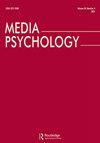双耳和立体声故事的沉浸式加工的三维声功率和心理生理效应
IF 2.6
2区 心理学
Q1 COMMUNICATION
引用次数: 0
摘要
许多人在播客和有声书中听小说故事。一些技术,如3D或双耳声音,可能会改善听众在这种格式下的感官体验。然而,用双耳声音制作的音频作品很少,关于双耳声音对认知加工的影响的研究也很少。因此,本研究旨在分析双耳故事与立体声故事对听者认知加工和生理反应的影响。50名参与者听了两种版本的故事:双耳和立体声,他们评估了享受、参与和想象,同时测量了他们的生理反应(心率和皮肤电活动)。此外,他们还进行了识别测试。结果表明,双耳版本比立体声版本具有更高的叙事参与,享受,意象和信息识别。心理生理反应表明,双耳故事的注意力和唤醒程度最高。披露声明作者未报告潜在的利益冲突。在本研究中,我们专注于双耳音频再现,旨在通过声音再现空间方向来创造身临其境的听觉感受(Geronazzo等人,Citation2019)。相比之下,根据Lane等人(Citation1998)的说法,双耳节拍指的是同时出现的两种不同频率的音调,每只耳朵一个,因此听者感知到的是振幅变化的单一音调。有人认为双耳节拍可能会影响精神运动表现和情绪(Lane et al., Citation1998)。值得注意的是,一些研究交替使用了双耳和3D音频的概念(例如,Paterson & Lee, Citation2022)。在本研究中,我们分析了双耳音频的效果,我们之前将双耳音频定义为一种音频再现形式,旨在通过用声音再现空间方向来创造身临其境的听觉感受(Geronazzo等人,Citation2019)。然而,3D音频也被定义为“模拟真实聆听体验的逼真声音”(Shin等人,Citation2019,第81页)。其他作者通过说双耳音频是3D音频的最简单形式来区分这两个术语(Boren, Citation2018)。由于需要对术语有更多的共识,以及之前关于这一主题的研究的稀缺性,我们回顾了使用双耳音频或3D音频的研究。一些作者将叙事参与和叙事转移作为类似或相关的概念(例如,Gebbers等人,Citation2017;绿色,Citation2021;chernev等人,Citation2023)或可互换(例如Cohen等人,Citation2023;Samur et al., Citation2021)。其他作者认为叙事运输和叙事参与是叙事参与的两个不同维度(例如,Quintero Johnson & Sangalang, Citation2017)。继Busselle和Bilandzic (Citation2009)之后,在本研究中,我们采用了“叙事参与”一词,我们认为它与叙事说服类似。本研究得到了Leonardo BBVA [IN[18]_COM_COM_0041]的支持。第二作者拥有Ramón y Cajal Grant (RYC2021-033612-I),由MCIN/AEI/10.13039/501100011033和欧盟NextGenerationEU/PRTR资助。本文章由计算机程序翻译,如有差异,请以英文原文为准。
The 3D Sound Power of Immersion Processing and Psychophysiological Effects of Binaural versus Stereo Audio Stories
ABSTRACTMany people are listening to fiction stories in podcasts and audiobooks. Some techniques, such as 3D or binaural sound, might improve the listeners’ sensory experience in this kind of format. However, few audio productions are produced with binaural sound, and research about their effects on cognitive processing is scarce. Therefore, this study aims to analyze the impact of binaural sound in audio stories compared to their stereo versions on the listeners’ cognitive processing and physiological responses. Fifty participants listened to two stories produced in two versions: binaural and stereo, and they assessed enjoyment, engagement, and imagery while their physiological responses were measured (heart rate and electrodermal activity). Also, they performed a recognition test. The results showed that the binaural version achieved higher narrative engagement, enjoyment, imagery, and information recognition than the stereo stories. The psychophysiological responses indicated the highest attention and arousal in binaural stories. Disclosure statementNo potential conflict of interest was reported by the author(s).Notes1. In this study, we focus on binaural audio reproduction, which aims to create an immersive auditory sensation by recreating spatial orientation with sound (Geronazzo et al., Citation2019). In contrast, according to Lane et al. (Citation1998), binaural beats refer to two tones of different frequencies presented simultaneously, one to each ear, so that the listener perceives a single tone that varies in amplitude. It has been suggested that binaural beats might affect psychomotor performance and mood (Lane et al., Citation1998).2. It is important to note that several studies have used the concepts of binaural and 3D audio interchangeably (e.g., Paterson & Lee, Citation2022). In this study, we analyze the effect of binaural audio, which we previously defined as a form of audio reproduction that aims to create an immersive auditory sensation by recreating spatial orientation with sound (Geronazzo et al., Citation2019). However, 3D audio has also been defined as “realistic sound that simulates the real listening experience” (Shin et al., Citation2019, p. 81). Other authors have distinguished between these two terms by saying that binaural audio is the simplest form of 3D audio (Boren, Citation2018). Due to the need for more agreement on the terminology and the scarcity of previous research on this topic, we review studies using binaural audio or 3D audio.3. Some authors have used narrative engagement and narrative transportation as similar or related concepts (e.g., Gebbers et al., Citation2017; Green, Citation2021; Tchernev et al., Citation2023) or interchangeably (e.g., Cohen et al., Citation2023; Samur et al., Citation2021). Other authors consider narrative transportation and narrative engagement as two different dimensions of narrative involvement (e.g., Quintero Johnson & Sangalang, Citation2017). Following Busselle and Bilandzic (Citation2009), in this study, we adopt the term “narrative engagement,” and we consider it a similar concept to narrative persuasion.Additional informationFundingThis work was supported by Leonardo BBVA [IN[18]_COM_COM_0041]. The second author has a Ramón y Cajal Grant (RYC2021-033612-I) funded by MCIN/AEI/10.13039/501100011033 and the European Union NextGenerationEU/PRTR.
求助全文
通过发布文献求助,成功后即可免费获取论文全文。
去求助
来源期刊

Media Psychology
Multiple-
CiteScore
8.60
自引率
7.10%
发文量
30
期刊介绍:
Media Psychology is an interdisciplinary journal devoted to publishing theoretically-oriented empirical research that is at the intersection of psychology and media communication. These topics include media uses, processes, and effects. Such research is already well represented in mainstream journals in psychology and communication, but its publication is dispersed across many sources. Therefore, scholars working on common issues and problems in various disciplines often cannot fully utilize the contributions of kindred spirits in cognate disciplines.
 求助内容:
求助内容: 应助结果提醒方式:
应助结果提醒方式:


